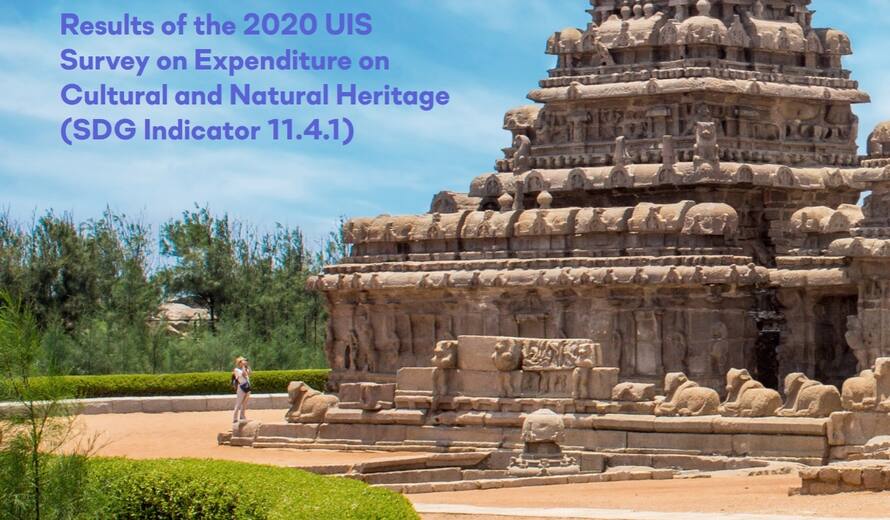UNESCO Institute for Statistics Releases Key Findings in New Cultural and Natural Heritage Report
The UNESCO Institute for Statistics (UIS) has released the first set of data for Indicator 11.4.1 related to culture for the Sustainable Development Goal (SDG) Agenda 2030. The results and analysis are available in a new report, Tracking Investment to Safeguard the World’s Cultural and Natural Heritage.
Indicator 11.4.1 is defined as “total per capita expenditure on the preservation, protection and conservation of all cultural and natural heritage, by source of funding (public, private), type of heritage (cultural, natural) and level of government (national, regional and local/municipal).”
Crucial Role of Collecting Data in the Midst of COVID
Activities associated with preserving our cultural and natural heritage are multifaceted and complex with many benefits to society ranging from employing cultural workers to educational activities in museums. The COVID-19 pandemic resulted in major impacts for the culture sector and for heritage preservation, as tourism fell and some 95% of the world’s museums closed during the crisis in April 2020. World Heritage sites all around the world have been impacted by the pandemic. Data has a crucial role to play in providing information so that we can ensure that our cultural and natural heritage remain strong for generations to come.
This first survey to collect data on culture and natural heritage expenditure took place between June 2020 and February 2021, and while the pandemic complicated reporting for many countries, these data mark an important first step in fulfilling global commitments to safeguarding our natural and cultural heritage for the Agenda 2030. Indicator 11.4.1 is the first indicator of the UNESCO Culture|2030 Indicators framework indicating expenditure on heritage. Going forward, the UIS has planned a series of webinars and will offer additional technical support to Member States to increase survey participation, data quality and that would also contribute to the implementation of the UNESCO Culture|2030 Indicators.
Key Results and Analysis
Sixty-two countries responded to the survey and 29 had sufficiently robust data of a high enough quality to include in the indicator calculations. Of these, 28 countries were able to report public expenditure on cultural and natural heritage and six (Finland, Mexico, Poland, Portugal, Spain, Sweden) were able to provide data to calculate the entire indicator.
Half of the countries (13 countries) reporting data on public expenditures were from Europe and Northern America. They spent, on average, PPP$ 75 per capita to protect heritage in 2019, ranging from PPP$ 6 in Moldova to PPP$ 162 in Hungary.
An analysis of expenditure by level of government revealed that of the seven countries reporting spending by local government, (Belarus, Brazil, Ecuador, France, Hungary, Peru, Turkey) expenditures were higher than the national or federal level in five of them (Belarus, Brazil, France, Turkey, Spain), pointing to the importance of municipalities in preserving heritage.
Comparing public expenditure on cultural and natural heritage against all expenditure on cultural and natural activities showed a wide range of outcomes within each SDG region. The five reporting countries from Latin America and the Caribbean (Brazil, Ecuador, Mexico, Peru, Nicaragua), for example, spent less than PPP$ 20 per capita on cultural and natural heritage, though the proportion of heritage spending within culture ranged from 75% in Ecuador to 20% in Mexico.
Moving Ahead: UIS Initiatives
Looking forward, this survey is a key step towards demonstrating the multifaceted contribution of culture to sustainable development – a crucial endeavor in contributing to the UNESCO Culture|2030 Indicators in the run-up to the UNESCO Global Conference on Cultural Policies and Sustainable Development – Mondiacult II in 2022.
The UIS will organize a meeting in July 2021 with countries and selected international agency/organization representatives to share best practices for collecting data and to identify compilation issues and to strengthen its alignment with the UNESCO Culture|2030 Indicators. A second data collection cycle is planned for 2021 and to support countries during this second wave also to support the pilot phase of implementation of the UNESCO Culture|2030 Indicators. The UIS is planning five webinars in September 2021 to provide instructions on the completion of the survey and guidance on compilation.
Resources:
Tracking Investment to Safeguard the World’s Cultural and Natural Heritage: Results of the 2020 UIS Survey on Expenditure on Cultural and Natural Heritage (English, French, Spanish).


